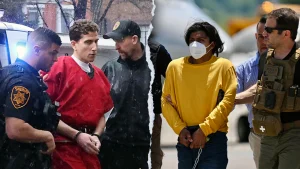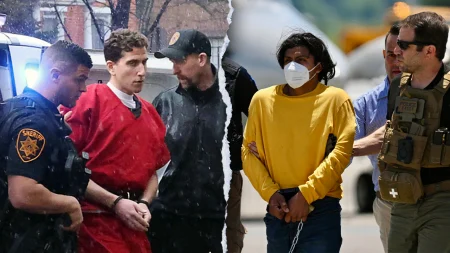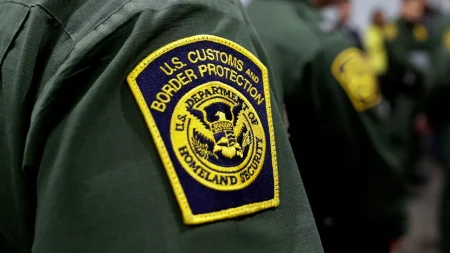Quincy Divided: Religious Statues Spark Constitutional Debate
In the coastal city of Quincy, Massachusetts, a heated controversy has emerged over plans to install two towering bronze statues of Catholic saints outside the new $150 million Public Safety Building. The 10-foot sculptures of Saint Michael the Archangel and Saint Florian, costing a combined $850,000, were commissioned by Mayor Thomas P. Koch in 2023 to honor first responders. However, this artistic decision has divided the community along constitutional lines, raising fundamental questions about religious symbolism in public spaces. The dispute highlights the delicate balance between honoring tradition and maintaining separation of church and state in a diverse society.
At the heart of the controversy are differing interpretations of these religious figures and their appropriate place in civic life. Joe Davis, senior counsel at the Becket Fund for Religious Liberty, argues the statues reflect “a centuries-old artistic and cultural tradition of honoring courage and sacrifice, not a violation of the Constitution’s separation of church and state.” Davis frames the issue as a city simply trying to “beautify a public space and honor those who put their lives on the line every day,” noting that Saint Michael and Saint Florian are “figures that are important to firefighters and police officers around the world.” Mayor Koch shares this perspective, stating the statues were chosen to “honor and protect” first responders, many of whom carry medals or prayer cards bearing these saints’ images. The sculptures are being created by artist Sergey Eylanbekov, who previously designed public monuments of John Adams and John Hancock for Quincy.
Opposition to the statues has been substantial and organized. In May 2025, the American Civil Liberties Union of Massachusetts, joined by the Freedom From Religion Foundation and Americans United for Separation of Church and State, filed a lawsuit on behalf of 15 residents from various faith traditions. Their central claim is that using taxpayer money to display Catholic imagery on government property violates both the Massachusetts Constitution and the First Amendment’s Establishment Clause. The plaintiffs argue that the statues send an “exclusionary message” suggesting that non-Catholic residents “are second-class citizens who should not feel safe or equally respected” by their government. A petition opposing the installation gathered more than 1,600 signatures, while an interfaith coalition of 19 clergy members from Catholic, Jewish, Unitarian and Protestant congregations issued a statement warning that the display “sends a message that there are insiders and outsiders in this community.” Critics have also expressed concern that the project was commissioned without public notice or City Council approval.
The ACLU’s February letter to city officials stated that the plan “plainly violates” the Massachusetts Declaration of Rights, asserting that “placing larger-than-life statues of Catholic saints in front of a public building unequivocally advances one religion to the exclusion of all others.” The organization specifically noted that the imagery of Saint Michael standing on a demon’s neck was “particularly abhorrent” and “reminiscent of brutal force.” The lawsuit contends that the statues fail all four parts of the Massachusetts Supreme Judicial Court’s test for determining religious neutrality—a test that, while abandoned by the federal Supreme Court in 2022, continues to be applied under the state constitution. In response to these legal challenges, a judge has issued a temporary injunction halting the installation of the statues.
Davis and the Becket Fund plan to appeal this injunction, hoping the case will clarify whether public symbols with religious origins can exist in civic spaces when used for secular or historical purposes. Davis rejected the ACLU’s claims, arguing that the city’s intent aligns with long-standing American traditions of civic art that carry religious associations. “If we say that a symbol cannot be displayed in public just because it has religious associations for some, that’s going to require us to take down quite a bit of public imagery across this country,” Davis pointed out. He drew a parallel to the U.S. Supreme Court, which features a statue of Moses holding the Ten Commandments: “It has religious meaning, yes, but it also symbolizes law and justice. The same is true here.” Davis also compared Quincy’s statues to the Bladensburg Peace Cross, a World War I memorial in Maryland that the U.S. Supreme Court upheld as constitutional in 2019.
The case could soon reach the Massachusetts Supreme Judicial Court, where justices will weigh whether public art incorporating religious imagery violates the state’s constitutional separation of church and state. The outcome may set a significant precedent regarding religious symbols in public spaces. Davis expressed concern that removing symbols based solely on religious associations would provide “a really imbalanced and inaccurate presentation of our history and culture if the religious aspects had to be sort of scrubbed out.” Meanwhile, the statues remain in storage overseas, awaiting shipment to Quincy later this year, as city officials have committed to “stay quiet on the affixing front” while the legal battle continues. Davis summarized his perspective: “Quincy is doing what cities have done for centuries—using art to honor the people who protect and serve. That’s not a religious act. It’s an act of gratitude.” As this case unfolds, it represents more than just a local dispute; it touches on fundamental questions about how communities balance religious heritage, artistic expression, and constitutional principles in an increasingly diverse America.










